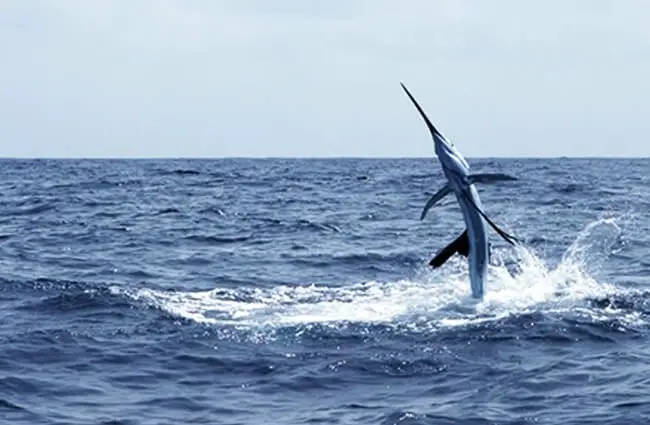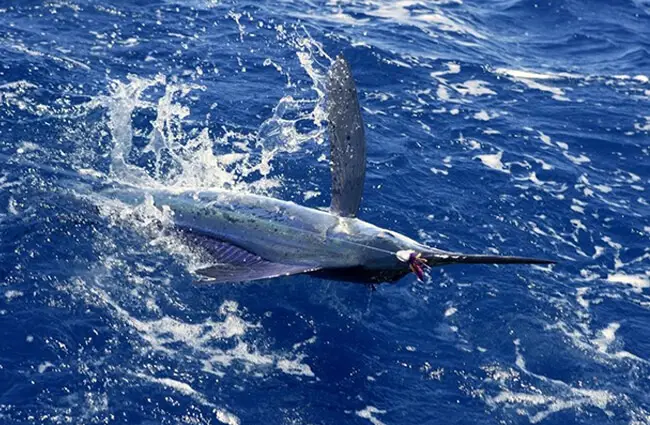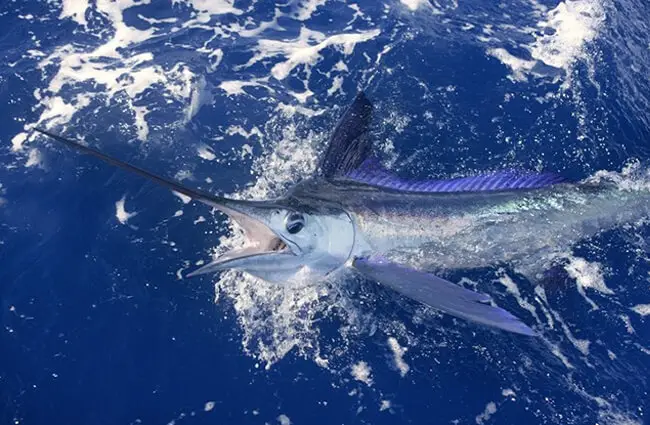The Majestic White Marlin: A Deep Dive into the Ocean’s Spear
The white marlin, Kryx jubatus, is a magnificent billfish renowned for its speed, elegance, and the captivating spectacle it creates when breaching the ocean surface. This apex predator holds a significant place in both marine ecosystems and human culture, commanding respect from scientists, anglers, and ocean enthusiasts alike. This comprehensive guide explores all facets of the white marlin, from its natural history and behavior to its conservation status and interaction with humans.

I. Natural History and Physical Characteristics
The white marlin is characterized by its slender, streamlined body, elongated bill, and a prominent dorsal fin that is more rigid and upright compared to other marlin species. Adults typically reach lengths of 6.5 to 8.5 feet and weigh between 75 and 190 pounds, though larger individuals have been recorded. Its coloration is a striking silvery white on the dorsal side and flanks, transitioning to a pale blue on the lower body. This camouflage helps it blend with the sunlit surface waters where it hunts. The bill, a modified extension of the upper jaw, is used to slash and stun prey.
A. Evolution and Taxonomy
White marlins, like other billfishes, belong to the Istiophoridae family. Their evolutionary lineage traces back to the Eocene epoch, approximately 56 to 34 million years ago. Fossil records suggest that early billfishes were more widespread geographically and exhibited greater diversity. The white marlin, as a distinct species, likely emerged through a gradual adaptation to specific oceanic conditions and prey availability within the Atlantic Ocean. Phylogenetic studies using genetic markers continue to refine our understanding of its relationship to other marlin and sailfish species.
II. Habitat and Distribution
The white marlin is primarily found in the warm temperate and tropical waters of the Atlantic Ocean. Its core range extends from the eastern coast of the United States, throughout the Caribbean Sea and the Gulf of Mexico, to the coasts of West Africa and the Mediterranean Sea. It is a pelagic species, meaning it inhabits the open ocean rather than coastal waters. White marlins exhibit migratory behavior, following ocean currents and prey concentrations. During the summer months, they are commonly found near the northeastern coast of the United States, particularly off the coasts of North Carolina and Virginia.

III. Diet and Feeding Behavior
As an apex predator, the white marlin occupies the top trophic level in its ecosystem. Its diet primarily consists of fish, including mahi-mahi, tuna, and various smaller schooling fish. It also preys on squid, crustaceans, and occasionally sea turtles. White marlins employ a hunting strategy that involves locating schools of prey and then using their bill to slash and incapacitate individual fish. They are known for their speed and agility, enabling them to pursue and capture fast-moving prey. Opportunistic feeders, they will also consume injured or weakened animals.
IV. Reproduction and Life Cycle
White marlins are broadcast spawners, meaning they release eggs and sperm into the water column for external fertilization. Spawning occurs in the warmer months, typically between May and October, within the Atlantic Ocean’s warmer currents. Females release millions of buoyant eggs, which drift with the currents and hatch into larvae. The larvae undergo a period of rapid growth and development, feeding on plankton and small crustaceans. Juvenile marlins gradually transition to a diet of fish and squid. Sexual maturity is thought to occur between three and five years of age. Little is known about the specific mating behaviors of white marlins, but they are believed to engage in elaborate displays to attract mates.

V. Ecological Role and Interactions
White marlins play a crucial role in maintaining the balance of their marine ecosystem. As apex predators, they help regulate populations of prey fish and prevent overgrazing of plankton. They also serve as indicators of ocean health. Their presence and abundance can reflect the overall condition of the food web and the quality of the marine environment. They interact with other large pelagic species, including sharks, tuna, and other billfishes. Competition for food and habitat can occur, but white marlins generally occupy a unique ecological niche. They are also occasionally preyed upon by large sharks, particularly tiger sharks and mako sharks.
VI. White Marlin and Humans
Throughout history, white marlins have held cultural significance for coastal communities. They are revered as symbols of strength, beauty, and the power of the ocean. In many cultures, they feature prominently in art, folklore, and traditional fishing practices. However, the white marlin has also been targeted by commercial and recreational fisheries. Historically, fishing pressure led to significant population declines. Today, responsible fishing practices and conservation efforts are essential to ensure the long-term survival of this magnificent species.
A. Conservation Status and Threats
The white marlin is currently listed as Near Threatened by the International Union for Conservation of Nature (IUCN). Its populations have declined significantly in recent decades due to overfishing, bycatch, and habitat degradation. Bycatch, the unintentional capture of non‑target species in fishing gear, poses a major threat. Climate change and ocean acidification also contribute to habitat loss and disruptions in the food web. Conservation efforts include implementing stricter fishing regulations, promoting sustainable fishing practices, and establishing marine protected areas.

B. Responsible Interactions and Viewing in the Wild
If you are fortunate enough to encounter a white marlin in the wild, observe it from a respectful distance. Avoid approaching or harassing the animal. Do not feed it, as this can alter its natural behavior and make it dependent on humans. If you are fishing, use circle hooks and release any marlin you catch quickly and carefully. Support organizations dedicated to marine conservation and responsible fisheries management.
VII. Expert Insights for Zoologists and Aquarists
For aspiring zoologists and aquarists, the white marlin presents unique challenges and opportunities. Studying their behavior in the wild requires advanced tracking technologies and a thorough understanding of their migratory patterns and habitat preferences. Maintaining white marlins in captivity is extremely difficult due to their large size, complex dietary needs, and sensitivity to environmental stressors. Successful captive care requires spacious tanks, carefully controlled water quality, and a diet that mimics their natural prey. Research on white marlin genetics, physiology, and reproductive biology is essential for developing effective conservation strategies.
VIII. Fascinating Facts
- White marlins can reach speeds of up to 80 miles per hour.
- Their bill contains sensory organs that help them detect prey.
- Female white marlins are generally larger than males.
- They are known to breach, leaping out of the water and “dancing” on their tails.
- White marlins are highly migratory, traveling thousands of miles across the Atlantic Ocean.

Conclusion
The white marlin remains one of the ocean’s most captivating and majestic creatures. Its elegance, speed, and ecological importance demand our respect and protection. By understanding its natural history, threats, and conservation needs, we can ensure that future generations have the opportunity to marvel at this incredible species.

![Red Angus Closeup of a beautiful Red Angus cowPhoto by: U.S. Department of Agriculture [pubic domain]https://creativecommons.org/licenses/by/2.0/](https://animals.net/wp-content/uploads/2020/03/Red-Angus-4-238x178.jpg)




![Red Angus Closeup of a beautiful Red Angus cowPhoto by: U.S. Department of Agriculture [pubic domain]https://creativecommons.org/licenses/by/2.0/](https://animals.net/wp-content/uploads/2020/03/Red-Angus-4-100x75.jpg)

